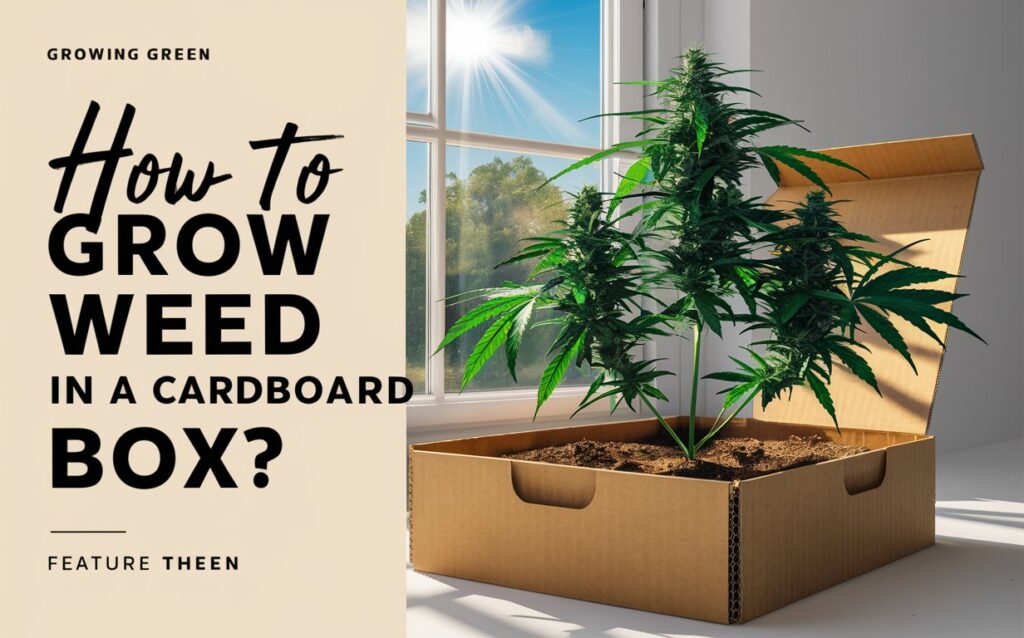Growing cannabis in a cardboard box might sound unusual, but with the right setup, it can be a convenient and low-cost option for small-scale growers. This method is particularly suited for those who want a discreet and compact growing environment that doesn’t require an elaborate setup. A cardboard box offers a manageable space for beginner and hobbyist growers, provided the conditions are carefully controlled.
Whether you’re exploring cultivation as a personal hobby or want to try new methods, a cardboard box setup can work surprisingly well. Plus, with subscription services like weed sub boxes available, you can easily access the necessary growing materials and even experiment with different strains and tools to enhance your growing experience.
How to Grow Weed in a Cardboard Box?
Step 1: Choosing the Right Cardboard Box
Your growing box forms the foundation of your setup, so choosing the right one is crucial. Here’s what you need to consider:
- Size and Strength: Opt for a large, sturdy cardboard box that can support lighting, ventilation, and the weight of your plants. The box should be at least 2-3 feet tall to give the plants room to grow.
- Accessibility: Ensure you can easily access the box interior for watering, pruning, and checking the plants.
To maximize your results, consider enhancing your setup with reflective material, like Mylar or aluminum foil, which helps spread light evenly. This step will significantly improve the efficiency of your lighting and create a balanced growth environment for your plants.
Step 2: Setting Up Ventilation and Airflow
Proper airflow is essential in a small growing space to prevent mold and ensure the plants get enough CO₂. Here’s how to set up ventilation in a cardboard box:
- Create Ventilation Holes: Use a knife to cut small holes near the top and bottom of the box. Hot air will naturally escape from the top, while cooler air will enter from the bottom, creating passive airflow.
- Add a Small Fan: For additional air circulation, consider adding a small USB or battery-powered fan. Position it so that it gently blows across the plants without directly impacting them. This will help keep the environment fresh and reduce the risk of mold growth.
Step 3: Lighting for Optimal Growth
Lighting is one of the most important factors in growing cannabis indoors, especially in a confined space like a cardboard box. Cannabis plants require around 18-24 hours of light during the vegetative stage and 12 hours during the flowering stage. Here are some lighting options:
- LED Lights: Compact and energy-efficient, LED lights produce minimal heat, which is ideal for a small space like a cardboard box. They can be adjusted to provide the necessary light spectrum for each growth stage.
- CFL (Compact Fluorescent Lamp): These are affordable, produce low heat, and are available in different wattages. Position the lights close enough to the plants for effective growth but far enough to prevent burning.
Use reflective material inside the box to maximize the light, ensuring that your plants receive sufficient illumination from all angles.
Step 4: Temperature and Humidity Control
Cannabis thrives in a specific temperature and humidity range, so maintaining these levels in a cardboard box can be challenging but is essential for successful growth. Here are some key guidelines:
- Temperature: Cannabis plants grow best between 70-85°F (20-30°C) during the day and 60-70°F (15-20°C) at night. Avoid exposing the cardboard box to direct sunlight or placing it near a heater, as this can lead to overheating.
- Humidity: During the vegetative stage, maintain humidity around 40-70%. In the flowering stage, lower it to around 40-50% to prevent mold formation on the buds.
You can use a small hygrometer to monitor humidity and temperature levels. A mini dehumidifier may also be useful if humidity is difficult to control, especially during the flowering stage.
Step 5: Selecting and Setting Up the Growing Medium
The choice of soil or hydroponic setup will depend on your preference and experience level. For beginners, soil is recommended due to its ease of use and accessibility. You can even find soil and nutrients delivered directly to your door with weed subscription boxes service. Here’s what you need to get started:
- Soil: Choose high-quality soil with a balanced nutrient mix and good drainage.
- Containers: Small pots or solo cups work well inside a cardboard box. Make sure to create drainage holes to prevent water from pooling.
Hydroponic systems are also an option but may require more equipment and a greater level of maintenance to achieve optimal growth.
Step 6: Planting and Growing Your Cannabis
Once your setup is ready, it’s time to start planting. Place your seeds or seedlings in the soil and give them the right amount of light, water, and nutrients. Here’s how to care for your plants as they grow:
- Watering: Keep the soil moist but avoid overwatering, as it can lead to root rot. Water when the top inch of soil feels dry.
- Nutrients: Feed your plants with nutrients designed for cannabis at each stage of growth. Be cautious not to over-fertilize, which can damage the plants.
Throughout the vegetative stage, your plants will grow taller, developing leaves and stems. As they transition to the flowering stage, they’ll require more focused care and nutrients to produce buds.
Step 7: Flowering and Harvesting
The flowering stage is when your cannabis plants begin to produce buds. This stage typically lasts 6-10 weeks, depending on the strain. During this period, switch to a 12-hour light schedule and lower the humidity to prevent mold. Here are some essential tips for a successful flowering phase:
- Monitor for Signs of Maturity: Look for changes in the color of pistils (small hair-like structures on the buds) and the formation of trichomes (tiny resin glands on the buds).
- Flush: A week or two before harvest, flush your plants by watering them without nutrients to remove excess salts and improve flavor.
When the plants are ready for harvest, carefully cut and trim the buds, leaving them to dry in a controlled environment for optimal potency and flavor.
Advantages of Growing Weed in a Cardboard Box
While growing cannabis in a cardboard box has its challenges, there are some advantages to this method:
- Affordability: Cardboard boxes are inexpensive, making this a budget-friendly option.
- Compact Space: Ideal for small grows and limited spaces, such as apartments or small rooms.
- Discreet: The setup is easy to hide and manage, which can help maintain privacy.
The Bottom Line
Growing cannabis in a cardboard box may seem unconventional, but it offers a surprisingly effective solution for hobbyists and those looking for a low-cost, space-efficient growing method. With careful attention to light, humidity, and temperature, you can achieve a high-quality yield. Just remember to check on your plants daily and make small adjustments as needed to keep them healthy and thriving.
At Greeen Box, we offer the ultimate convenience with our monthly weed box, filled with premium tools, nutrients, and seeds delivered right to your door. Find new strains, experiment with quality products, and get the resources you need to grow like a pro—all in our weed subscription boxes. With Greeen Box, you’re not just growing cannabis; you’re cultivating an experience.
Get started today and see the difference!



